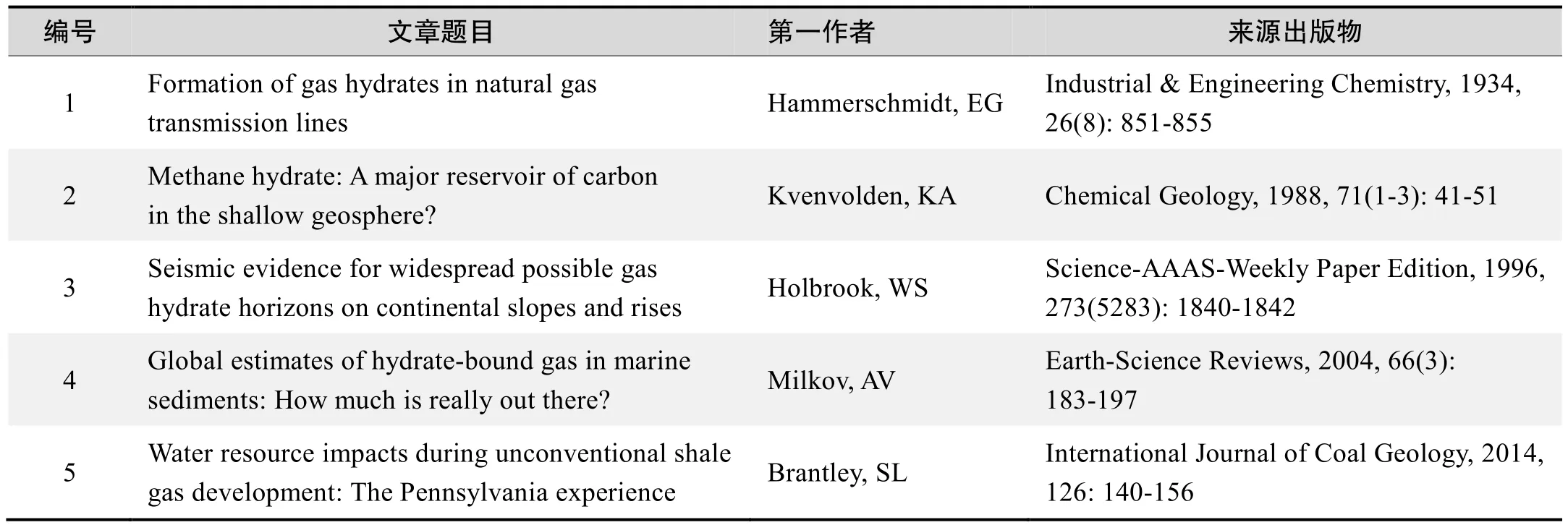经典文献推荐
2017-08-12Methanehydratemajorreservoirofcarbonintheshallowgeosphere
Methane hydrate: A major reservoir of carbon in the shallow geosphere?
Kvenvolden, KA
Seismic evidence for widespread possible gas hydrate horizons on continental slopes and rises
Shipley, TH; Houston, MH; Buffler, RT; et al.
Global estimates of hydrate-bound gas in marine sediments: How much is really out there?
Milkov; AV
经典文献推荐
基于Web of Science检索结果,利用Histcite软件选取LCS(Local Citation Score,本地引用次数)TOP 30文献作为节点进行分析,得到本领域推荐的经典文献如下。

本领域经典文献
来源出版物:Industrial & Engineering Chemistry, 1934,26(8): 851-855
Methane hydrate: A major reservoir of carbon in the shallow geosphere?
Kvenvolden, KA
Abstract:Methane hydrates are solids composed of rigid cages of water molecules that enclose methane. Sediment containing methane hydrates is found within specific pressure-temperature conditions that occur in regions of permafrost and beneath the sea in outer continental margins. Because methane hydrates are globally widespread and concentrate methane within the gas-hydrate structure, the potential amount of methane present in the shallow geosphere at subsurface depths of <∼2000 m is very large. However, estimates of the amount are speculative and range over about three orders of magnitude, from 2 × 103to 4 × 106Gt (gigatons = 1015g) of carbon, depending on the assumptions made. The estimate I favor is ∼ 1 × 104Gt of carbon. The estimated amount of organic carbon in the methane-hydrate reservoir greatly exceeds that in many other reservoirs of the global carbon cycle — for example, the atmosphere (3.6 Gt); terrestrial biota (830 Gt); terrestrial soil, detritus and peat (1960 Gt);marine biota (3 Gt); and marine dissolved materials (980 Gt). In fact, the amount of carbon may exceed that in all fossil fuel deposits (5 × 103Gt). Because methane hydrates contain so much methane and occur in the shallow geosphere, they are of interest as a potential resource of natural gas and as a possible source of atmospheric methane released by global warming. As a potential resource, methane hydrates pose both engineering and production problems. As a contributor to a changing global climate, destabilized methane hydrates, particularly those in shallow, nearshore regions of the Arctic Ocean,may have some effect, but this effect will probably be minimal, at least during the next 100 years.
来源出版物:Chemical Geology, 1988, 71(1-3): 41-51
Seismic evidence for widespread possible gas hydrate horizons on continental slopes and rises
Shipley, TH; Houston, MH; Buffler, RT; et al.
Abstract:Anomalous reflections in marine seismic reflection data from continental slopes are often correlated with the base of gas hydrated sedimentary rocks.Examination of University of Texas Marine Science Institute reflection data reveals the possible presence of such gas hydrates along the east coast of the United States,the western Gulf of Mexico, the coasts of northernColombia and northern Panama, and along the Pacific side of Central America in areas extending from Panama to near Acapulco, Mexico. Suspected hydrates are present in water depths of 700 to 4400 m and extend from 100 to 1100 m subbottom. Geometric relations, reflection coefficients, reflection polarity, and pressure-temperature relations all support the identification of the anomalous reflections as the base of gas hydrated sediments. In most places, gas hydrate association is related to structural anomalies (anticlines, dipping strata), which may allow gas to concentrate and migrate updip into pressure and temperature conditions suitable for hydrate formation. The gas hydrate boundary can be used to estimate thermal gradients. In general, thermal gradients estimated from the gas hydrate phase boundary are higher than reported thermal gradients measured by conventional means.
来源出版物:AAPG bulletin, 1979, 63(12): 2204-2213
Global estimates of hydrate-bound gas in marine sediments: How much is really out there?
Milkov; AV
Abstract:It is generally assumed that oceanic gas hydrates contain a huge volume of natural gases, mainly methane. The most widely cited estimate of global hydrate-bound gas is 21×1015m3of methane at STP (or∼10,000 Gt of methane carbon), which is proposed as a“consensus value” from several independent estimations.This large gas hydrate reservoir is further suggested as an important component of the global carbon cycle and as a future energy source. Here, I present a revised and updated set of well-justified global estimates and discuss how and why they changed over time. It appears that the global estimates of hydrate-bound gas decreased by at least one order of magnitude from 1970s–early 1980s (estimates on the order of 1017–1018m3) to late 1980s–early 1990s (1016m3) to late 1990s–present (1014–1015m3). The decrease of estimates is a result of growing knowledge of the distribution and concentration of gas hydrates in marine sediments and ongoing efforts to better constrain the volume of hydrate- bearing sediments and their gas yield.These parameters appear to be relatively well constrained at present through DSDP/ODP drilling and direct measurements of gas concentrations in sediments. The global estimate of hydrate-bound gas that best reflects the current knowledge of submarine gas hydrate is in the range (1–5)×1015m3(∼500–2500 Gt of methane carbon).A significantly smaller global gas hydrate inventory implies that the role of gas hydrates in the global carbon cycle may not be as significant as speculated previously.Gas hydrate may be considered a future energy source not because the global volume of hydrate-bound gas is large,but because some individual gas hydrate accumulations may contain significant and concentrated resources that may be profitably recovered in the future.
gas hydrate; methane; global estimates; carbon cycle; energy source
来源出版物:Earth-Science Reviews, 2004, 66(3):183-197
Water resource impacts during unconventional shale gas development: The Pennsylvania experience
Brantley, SL; Yoxtheimer, D; Arjmand, S; et al.
Abstract:Improvements in horizontal drilling and hydrofracturing have revolutionized the energy landscape by allowing the development of so-called “unconventional”gas resources. The Marcellus play in the northeastern U.S.A. documents how fast this technology developed: the number of unconventional Marcellus wells in Pennsylvania(PA) increased from 8 in 2005 to ~ 7234 today. Publicly available databases in PA show only rare evidence of contamination of surface and groundwaters. This could document that incidents that impact PA waters have been relatively rare and that contaminants were quickly diluted.However, firm conclusions are hampered by i) the lack of information about location and timing of incidents; ii) the tendency to not release water quality data related to specific incidents due to liability or confidentiality agreements; iii)the sparseness of sample and sensor data for the analytes of interest; iv) the presence of pre-existing water impairments that make it difficult to determine potential impacts from shale-gas activity; and v) the fact that sensors can malfunction or drift. Although the monitoring data available to assess contamination events in PA are limited, the state manages an online database of violations. Overall, one fifth of gas wells drilled were given at least one non-administrative notice of violation (NOV) from the PA regulator. Through March 2013, 3.4% of gas wells were issued NOVs for well construction issues and 0.24% of gas wells received NOVs related to methane migration intogroundwater. Between 2008 and 2012, 161 of the ~ 1000 complaints received by the state described contamination that implicated oil or gas activity: natural gas was reported for 56% and brine salt components for 14% of the properties. Six percent of the properties were impacted by sediments, turbidity, and/or drill cuttings. Most of the sites of groundwater contamination with methane and/or salt components were in previously glaciated northern PA where fracture flow sometimes allows long distance fluid transport. No cases of subsurface transport of fracking or flowback fluids into water supplies were documented.If Marcellus-related flowback/production waters did enter surface or ground-waters, the most likely contaminants to be detected would be Na, Ca, and Cl, but those elements are already common in natural waters. The most Marcellus-specific “fingerprint” elements are Sr, Ba, and Br. For example, variable Br concentrations measured in southwestern PA streams were attributed to permitted release of wastewaters from unconventional shale gas wells into PA streams through municipal or industrial wastewater treatment plants before 2011. Discharge has now been discontinued except for brines from a few plants still permitted to discharge conventional oil/gas brines after treatment. Overall, drinking water supply problems determined by the regulator to implicate oil/gas activities peaked in frequency in 2010 while spill rates increased through 2012. Although many minor violations and temporary problems have been reported, the picture that emerges from PA is that the fast shale-gas start may have led to relatively few environmental incidents of significant impact compared to wells drilled; however, the impacts remain difficult to assess due to the lack of transparent and accessible data.
关键词:unconventional shale gas; environmental impact;hydraulic fracturing; hydrofracturing; water quality;marcellus shale
来源出版物:International Journal of Coal Geology, 2014,126: 140-156
Formation of gas hydrates in natural gas transmission lines
Hammerschmidt, EG
Omitted.
